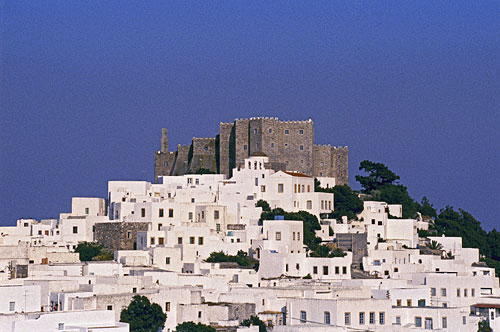Monastery of St. John, Patmos-Greece
Structure of the day_Monastery of St. John, Patmos
most important places of worship for Orthodox and Western Christians ...
Image source :http://gogreeceyourway.gr
The Monastery of St. John is one of the most important places of worship for Orthodox and Western Christians alike. It was founded in 1 088 by a monk, the Blessed Christodoulos, in honor of St. John the Divine, author of the Bible's Book of Revelation. One of the richest and most influential monasteries in Greece, its towers and buttresses make it look like a fairy-tale castle, but were built to protect its religious treasures, which are now the star attraction for the thousands of pilgrims and tourists who visit every year
THE BLESSED CHRISTODOULOS
The Christian monk C hristodoulos (slave of Christ) was born around 1020 in Asia Minor. He spent much of his life building monastenes on se~~eral Greek islands. He was given permiSSIOn by the Byzantine Emperor Alexios I C omnenos (r. 1081-1118) to build a temple on Patmos, 1n honor of the Apostles. Christodoulos laid the foundation stone for the Monastery of St John, but died in 1093 before it was completed. His remembrance celebrations are held each year in Patmos on March 16 and October 21.
Image source: http://www.patmostours.com/
NIPTIR CEREMONY
The Orthodox Easter celebrations on Patmos are some of the most important in Greece. Hundreds of people visit Ch6ra to watch the Niptir (washing) ceremony on Maundy Thursday. The abbot of the Monastery of St. John publicly washes the feet of 12 monks, reenacting Christ's washing of his disciples' feet before the Last Supper. The rite was once performed by the Byzantine emperors as an act of humility.
Chapel of the Holy Cross
This is one of the monastery's ten chapels, built because Church law forbade Mass to be heard more than once a day in the same chapel.
Image source : http://i298.photobucket.com/albums/mm271/tlcohio/PatmosChurch.jpg
THE TREASURY
Also known as the library, the treasury contains a vast and 1mportant collection of theological and Byzantine works. There is a central room, decorated with plastered arches supported by stone cdumns, off which lie other rooms display1ng religious artifacts. Priceless icons and sacred art, including vestments, chalices, and Benediction crosses, can be viewed. Floor-toceiling bookcases, built into the walls, store rei igious manuscripts and biographical materials, many written on parchment. Manuscripts of note 1nclude the Book of Job, sermons by St George the Theologue, the Purple Code, and a 14th-century voh . .me containing 1m ages of the Evangelists entitled Gospel of Foor. The treasury also possesses 15th-to 18th-century embrc.dered stools and mosaics, as well as beautiful 17th-century furnishings. There are also garments worn by past bishops, some woven in gold thread.
IMAGE SOURCE : http://mygreecetravelblog.com/
Monks' Refectory
This room contains two marble tables taken from the Temple of Arterris, which originally occupied the site.


0 Response to "Monastery of St. John, Patmos-Greece"
Post a Comment